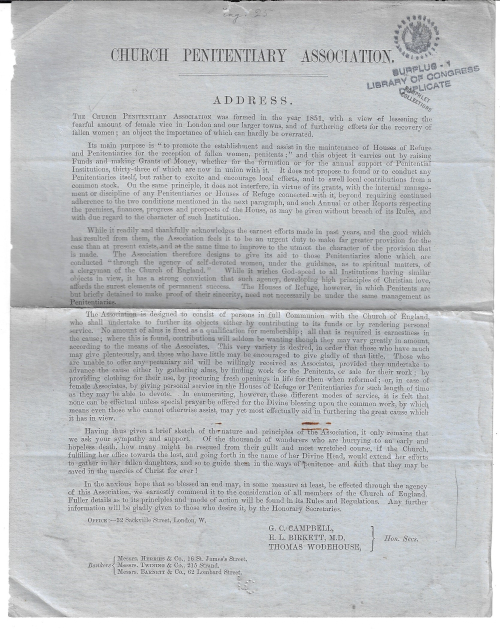Church Penitentiary Association, Address. 10x8" leaflet, printed on one side only, folded. London, ca. 1851.
Nice copy. Provenance: Library of Congress, with their tiny 6mm "LC" perforated stamp at bottom and the LC surplus/duplicate stamp on upper right corner. (Given the library from the Philadelphia Free Library in 1943. $125
This is a circular to introduce the association and solicit money for support. The Church Penitentiary Association was “...formed with a view of lessening the fearful amount of female vice in London and our larger towns...”
- “...House of Refuge and Penitentiaries for the reception of fallen women, penitents...designed to consist of persons in full Communion with the Church of England”.
- “Of the thousands of wanderers who are hurrying to an early and hopeless death, how many might be rescued from their guilt and most wretched course, if the Church, fulfilling her offices towards the lost...would extend her efforts to gather in her fallen daughters, and so guide them in the ways of penitence and faith that they may be saved...”
Scarce.
"The original Church penitentiary for the reclamation of fallen women was founded in 1806 in London, the most well known centre was set up by former British prime minister William Ewart Gladstone in 1848. Its aim was the convent-based rehabilitation of women, including prostitutes, thieves, the homeless, alcoholics etc. They were charitable organisations and not in place for the punishment of crimes. The Church Penitentiary Association existed from 1852 until 1951. There are records on the association in the Library at Lambeth Palace, the seat of the Archbishop of Canterbury in London, and in the National Archives."--Wikipedia
“ The Church Penitentiary Association was founded in 1852 and affiliated with the Church of England. The association was part of a movement to provide places of rehabilitation and shelter for destitute citizens such as prostitutes or homeless people. The penitentiaries were similar to Catholic convents in that the penitents were to remain celibate while they were in the penitentiary. As was evidenced by Rossetti’s “Goblin Market” there was a strong sense of sisterhood amongst the women and a mutual encouragement to keep from the temptation of the outside world. Often times the leadership of the penitentiaries would not allow women to leave the grounds of the institutions. The penitentiaries were met with some hostility from the English public. Most of the time their criticisms were informed by their anti-Catholic views, comparing the penitentiaries to Catholic convents. The movement helped extinguish the epidemic of prostitution in England and played a part in the larger reform efforts of the Victorian period.”--”Christina Rossetti and the Church Penitentiary Movement, November 22, 2013 by Chris Kennedy





Comments